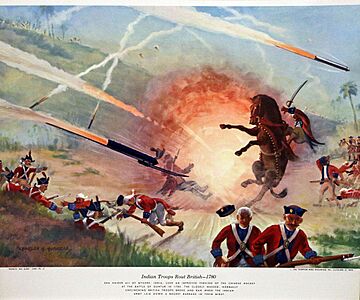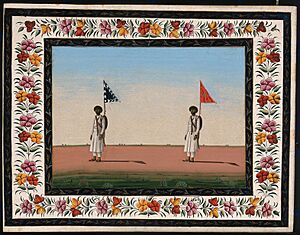Mysorean rockets facts for kids
Quick facts for kids Mysorean rocket |
|
|---|---|

A Mysorean soldier, using his rocket as a flagstaff (Robert Home, 1793/4).
|
|
| Type | Rocket |
| Place of origin | Kingdom of Mysore |
| Service history | |
| Used by | Hyder Ali and Tipu Sultan |
| Wars | Anglo-Mysore Wars |
| Specifications | |
| Length | 200 mm (7.9 in) |
| length | 1,000 mm (39 in) |
| Diameter | 38–76 mm (1.5–3.0 in) |
| Crew | 1 |
|
|
|
| Propellant | Black powder |
| References | |
Mysorean rockets were powerful weapons used by the army of the Kingdom of Mysore in India. These were the first successful rockets with iron casings. They were developed in the late 1700s under the rule of Hyder Ali and his son, Tipu Sultan.
The Mysorean army used these rockets very well against the British East India Company. This happened during the Anglo-Mysore Wars in the 1780s and 1790s. The British learned about this technology from these wars. This helped them create their own advanced rockets, like the Congreve rocket, in 1805.
Contents
Rocket Technology and Use in Battle
The Mysore Army had a special group of soldiers called the rocket corps. This group started with about 1,200 men during Hyder Ali's time. These soldiers were trained to use the rockets in battles.
During the Second Anglo-Mysore War, Mysorean rockets played a big role. At the Battle of Pollilur in 1780, a stray rocket hit a British ammunition store. This caused a huge explosion and helped the British lose the battle. Rockets also made it hard for British troops to move. They would skim along the ground, hurting soldiers.
Hyder Ali and Tipu Sultan used these rockets against the larger British forces. The British were very interested in this new technology. They later developed it further in the 1800s.
Mysorean rockets were special because they had iron tubes for the propellant. This allowed them to fly farther, up to 2 kilometers (about 1.2 miles). Rockets in Europe at that time did not have iron casings. This meant they could not fly as far. The iron casing made the rockets much stronger. This allowed them to hold more gunpowder and create a bigger push.
Tipu Sultan even ordered a military guide called Fathul Mujahidin. It said that 200 rocket men should be in each Mysorean brigade. These rocket men learned how to aim their rockets. They also used special wheeled launchers. These launchers could fire five to ten rockets at once.
The rockets came in different sizes. They usually had an iron tube about 20 centimeters (8 inches) long. This tube was about 3.8 to 7.6 centimeters (1.5 to 3 inches) wide. It was closed at one end and attached to a bamboo pole about 1.2 meters (4 feet) long. The iron tube held tightly packed black powder. A rocket with about 0.45 kilograms (1 pound) of powder could travel almost 914 meters (1,000 yards).
Tipu Sultan had a special laboratory for his rocket project. It was located in Bangalore, near the City Market.
Rockets in Mysorean Conflicts

Tipu Sultan used two rocket units in 1792 during the Third Anglo-Mysore War. One unit had 120 men, and the other had 131 men. Rockets were used to attack British forces near Srirangapatna. The Rocket Corps eventually grew to about 5,000 men in Tipu Sultan's army.
Mysorean rockets were also used for special events. When a group called the Jacobin Club of Mysore visited Tipu Sultan, 500 rockets were launched as part of a gun salute.
Rockets were used many times during the Fourth Anglo-Mysore War. One famous event involved Colonel Arthur Wellesley. He later became known as the First Duke of Wellington. Wellesley was almost defeated by Tipu's general at the Battle of Sultanpet Tope.
On April 22, 1799, rocket soldiers fired many rockets at the British camp. This was a signal for a large attack by Indian and French soldiers. The rockets could fly about 914 meters (1,000 yards). Some exploded in the air like bombs. Others bounced along the ground in a zigzag path. An English officer named Bayly said, "So pestered were we with the rocket boys that there was no moving without danger from the destructive missiles."
During the final British attack on Srirangapattana on May 2, 1799, a British shot hit a rocket storage area inside Tipu Sultan's fort. This caused a huge explosion. A large cloud of black smoke and bright lights shot up from the fort walls. The fort was captured in about an hour. Soon after, Tipu Sultan was killed, and the war ended.
British Use of Rocket Technology
After the British captured Srirangapattana, they found many rockets. They found 600 launchers, 700 working rockets, and 9,000 empty rocket casings. Some rockets had holes to cause fires. Others had iron points or steel blades attached to the bamboo poles. These blades made the rockets fly wildly at the end of their flight.
These experiences led the Royal Arsenal in Britain to start its own rocket research in 1801. They based their work on the Mysorean technology. Several rocket casings were sent to Britain for study. The British first showed their own solid-fuel rockets in 1805. William Congreve then wrote a book about the rocket system in 1807.
Congreve rockets were used by the British in the Napoleonic Wars and the War of 1812. They were also used in the 1814 Battle of Baltimore. These rockets are even mentioned in "The Star-Spangled Banner", the national anthem of the United States. The song says: And the rockets' red glare, the bombs bursting in air.
Discovering More Rockets
In 2002, some old metal shells were found in a well in Nagara, India. This area is about 60 kilometers (37 miles) from Shivamogga. About 100 of these rusted metal tubes were stored in a museum. At first, they were just called 'shells'.
In 2010, people thought these shells might be linked to Tipu Sultan's rockets. By 2013, their importance was fully recognized.
In April 2017, 102 unused rockets of different sizes were found in the Shimoga district. Then, in July 2018, another 500 rockets were found in an old well in the same area. This showed that the area was a major storage place for rockets under Tipu Sultan.
As of November 2019, more than 3,000 such rockets have been found. They were discovered during clean-up work in Nagara.




